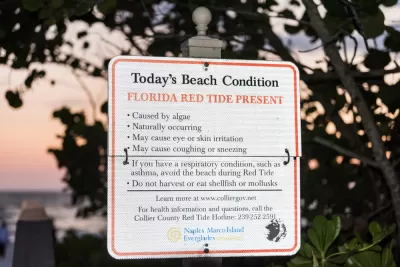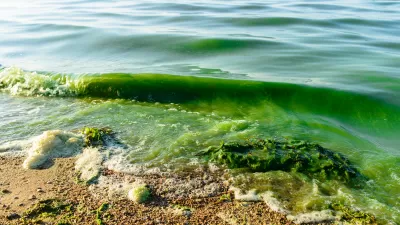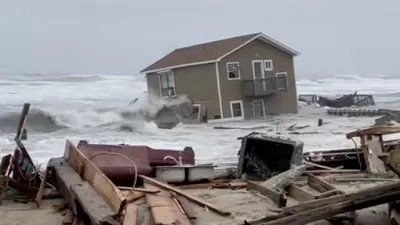A particularly devastating red tide is ravaging the southwest Florida coast. The question of whether humans have caused the intensity of the event is still up for debate, according to this article.

Maya Wei-Haas reports on the red tide devastating Florida's beaches this year, and asks the question of how much blame human activity can be assigned to the devastation.
Here's how Wei-Haas describes the cause and effect of the red tide:
Thousands of sea creatures now litter many of southern Florida’s typically picturesque beaches. Most are fish—mullet fish, catfish, pufferfish, snook, trout, grunt, and even the massive goliath grouper. But other creatures are also washing ashore—crabs, eels, manatees, dolphins, turtles, and more. It's a wildlife massacre of massive proportions. And the cause of both the deaths and toxic, stinging fumes is a bloom of harmful algae that scientists say is the region’s worst in over a decade.
The red tide takes its name from its rust-brown color, according to Wei-Haas, and in Florida "the culprit is usually the tiny, plant-like alga known as Karenia brevis, which produces toxins, dubbed brevetoxins, that cause both gastrointestinal and neurological problems when eaten."
Records of red tides in Florida date back to 1500, but this year's devastation has inspired a debate about whether humans are responsible for the scale of the devastation. The Karenia brevis is attracted to the Florida coast for natural reasons like salinity and temperature, but other researchers "believe the algae feeds on the nutrient-rich agricultural runoff from land, causing it to stick around for longer and rage more intensely," according to Wei-Haas. Red tides also tend to follow massive storms, which occur naturally, of course, but also have begun to increase in frequency and intensity due to the effects of human-caused climate change.
FULL STORY: Red Tide Is Devastating Florida's Sea Life. Are Humans to Blame?

Alabama: Trump Terminates Settlements for Black Communities Harmed By Raw Sewage
Trump deemed the landmark civil rights agreement “illegal DEI and environmental justice policy.”

Planetizen Federal Action Tracker
A weekly monitor of how Trump’s orders and actions are impacting planners and planning in America.

Why Should We Subsidize Public Transportation?
Many public transit agencies face financial stress due to rising costs, declining fare revenue, and declining subsidies. Transit advocates must provide a strong business case for increasing public transit funding.

Understanding Road Diets
An explainer from Momentum highlights the advantages of reducing vehicle lanes in favor of more bike, transit, and pedestrian infrastructure.

New California Law Regulates Warehouse Pollution
A new law tightens building and emissions regulations for large distribution warehouses to mitigate air pollution and traffic in surrounding communities.

Phoenix Announces Opening Date for Light Rail Extension
The South Central extension will connect South Phoenix to downtown and other major hubs starting on June 7.
Urban Design for Planners 1: Software Tools
This six-course series explores essential urban design concepts using open source software and equips planners with the tools they need to participate fully in the urban design process.
Planning for Universal Design
Learn the tools for implementing Universal Design in planning regulations.
Caltrans
Smith Gee Studio
Institute for Housing and Urban Development Studies (IHS)
City of Grandview
Harvard GSD Executive Education
Toledo-Lucas County Plan Commissions
Salt Lake City
NYU Wagner Graduate School of Public Service





























